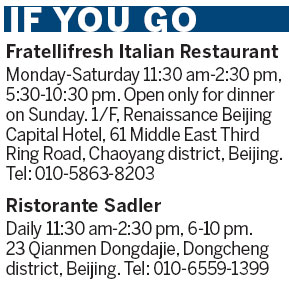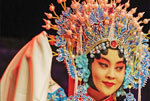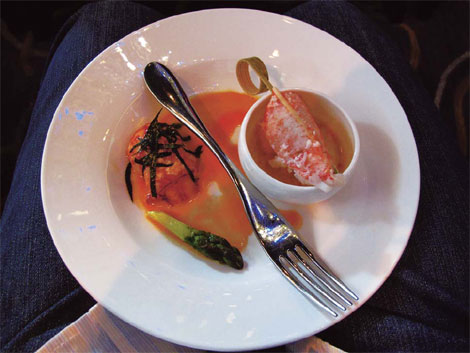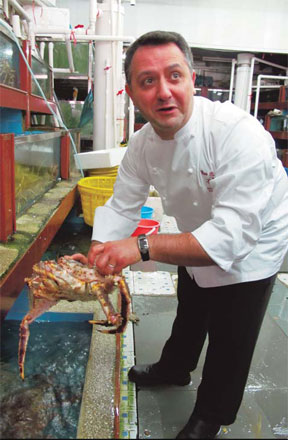Delicacies
It's always the season for fresh produce
Updated: 2011-05-14 07:28
By Ye Jun (China Daily)
|
A dish prepared by Michelin star chef Yannick Alleno. Photos by Ye Jun / China Daily |
A number of international chefs have been visiting Beijing of late to set up restaurants and source local ingredients for their new dishes. Ye Jun reports.
Beijing's Jingshen seafood market is bustling with life when Italian chef Eros Picco visits and compares it with markets in his country. He inquires about prices and photographs items he's interested in, such as a basket of silkworm pupa. He finds seafood that is also caught in Italy, such as king crabs, crayfish and squilla.
Later, at Xinfadi vegetable market, he discovers many vegetables he has never seen before, such as purple potatos, winter melons and a variety of eggs.
Picco takes a moment to share his method of choosing a fresh lobster: Does it make big movements? Are the head, tail and legs strong and active?
It is the chef's first tour of China and his restaurant - Innocenti Evasioni from Milan, which received a Michelin star in 2009 - was preparing to serve food for 10 days at Fratellifresh, the Italian restaurant on the first floor of Renaissance Beijing Capital Hotel, from May 11-22.
After three hours of looking around the markets, Picco decides to poach an Australian lobster weighing 1.5 kg for just 4 minutes in seething water, slices it, arranges it with slices of fresh snow beans and adds mashed vanilla for flavor.
|
Italian chef Eros Picco selects a fresh lobster at Beijing's Jingshen seafood market. |
The second course is a huge scallop from Dandong, Liaoning province. He tops the scallop with pesto and olive oil and light-roasts it for just 10 minutes, resulting in another sweet, tasty seafood dish. The chef improvises by frying the purple potato he found into thin, crisp slices, to match a pork fillet, along with fresh sugared peach.
The summer season sees some of the world's best chefs in Beijing, cooperating with locals or opening restaurants of their own.
On the same day as Picco's visit on April 9, Yannick Alleno - whose restaurant Le Meurice, in Paris, got three Michelin stars in 2007 - announces he will be cooperating with Shangri-La Hotel Beijing to open S.T.A.Y in September.
Like Picco, Alleno plans to use mostly local produce, partly because of freshness and quality, but also to keep costs down.
"Using and adapting local produce will be an exciting challenge that I believe will be both fruitful and inspiring," Alleno says.
He estimates the average bill to be 800 yuan ($123) a person. S.T.A.Y stands for "Simple Table Alleno Yannick", the chef's concept for the new restaurant.
"Most of the time, chefs add ingredients such as herbs. But I try to take out things to make it simple but original," he says. "I want to be as simple as possible, but in a well-planned way."
Alleno says he always tries to introduce a "wow effect" in dishes, such as sea urchin jelly with seaweed mousse, and a soup with onion cream.
The new restaurant, which will replace Blu Lobster, will be contemporary in style. It will offer a "communal table", a sharing table in the French style, for six to 10 people, and "conversation" furniture for lovers.
"I tried to imagine what people want from us and came up with three points," the chef says. "First, a sharing table where the chef takes care of you for good food. Second, we finish everything a la minute. I also want to make it a place where kids can come to play, and women can ask the chef about a cooking recipe."
Alleno describes his style as "creative, authentic to natural things, but also true to French tradition". He will bring a pastry chef, a cooking chef, and a manager from France to work with the Chinese team. He says he will visit China at least four times a year to change the menu and adds he usually creates 200 new dishes in a year.
Claudio Sadler, chef at Sadler Italian Restaurant, Ch'ien Men 23, also makes the trip to Beijing in May to cast an eye over his Ristorante Sadler, bringing six new dishes featuring seasonal produce. In 2010, the Michelin two-star chef from Milan visited China three times to introduce new dishes and prepare feasts for local gourmets.
 |
The Italian chef says his country has a long, thin shape and has a lot changes in the weather, so the menu changes eight or nine times a year.
"It is the season for a lot of fresh produce, such as asparagus, broad beans, artichokes, peppers and red onions," he says.
Sadler brings Italian olive oil to pair with his food this time. He displays four bottles at a media lunch. One is from Liguria, in northern Italy, which is delicate, light and suitable for vegetables, salads, boar and fish dishes. Another bottle of olive oil, from Lazio, is strong, bitter and fuller-bodied. The chef plans to use it for bean soup, pasta and grilled fish.
He believes the olive oil from Tuscany goes well with red meats and artichokes, while a Sicily olive oil with herb and artichoke notes can be paired with a variety of dishes, especially pasta, salad and fishes.
It was interesting to eat linguine with diced ossobuco sauce for the first course, because noodles are often the last course in a Chinese meal. The second course of suckling pig, "Porchetta style", with black truffles was fantastic. Interestingly, the artichoke used for the pork comes from Xinjiang, and the black truffle is sourced from Yunnan. Chef Riccardo La Perna says he uses local produce as long as the quality is good.
Specials

The song dynasty
There are MORE THAN 300 types of Chinese operas but two POPULAR varieties are major standouts

Sino-US Dialogue
China and the US hold the third round of the Strategic and Economic Dialogue from May 9-10 in Washington.

Building communities
American architect John Portman and his company have developed more than 30 projects across China.

